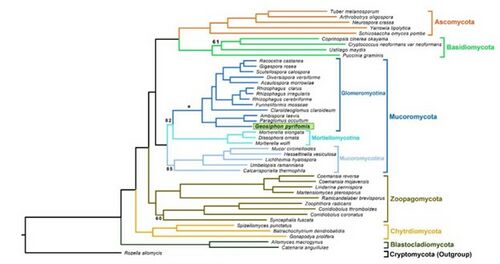Geosiphon-Nostoc Endosymbiosis: Difference between revisions
| Line 22: | Line 22: | ||
=Description and significance= | =Description and significance= | ||
Nostoc punctiforme is a filamentous cyanobacterium that can be photoautotrophic, diazotrophic, heterotrophic, and/or symbiotic. | Nostoc punctiforme is a filamentous cyanobacterium that can be photoautotrophic, diazotrophic, heterotrophic, and/or symbiotic. It is broadly symbiotic, forming relationships with fungi, bryophytes, gymnosperms, and angiosperms. Its genome contains a large number of unique genes that likely play essential roles in cell differentiation and symbiosis (Meeks et al., 2001). | ||
Geosiphon pyriformis is a | Geosiphon pyriformis is a fungus in the class Glomeromycetes, these fungi usually form arbuscular mycorrhizal symbiotic relationships with plants and cannot live without a symbiotic partner. Geosiphon pyriformis is the only fungus known form an endosymbiotic relationship with nitrogen-fixing cyanobacteria (Nostoc punctiforme). Microbiologists studying this relationship say that G. pyriformis represents an ideal candidate to investigate the origin of AMS (arbuscular mycorrhizal symbiosis) and the emergence of a unique endosymbiosis. (Malar et al., 2021). | ||
=16S Ribosomal RNA Gene Information= | =16S Ribosomal RNA Gene Information= | ||
Revision as of 14:54, 19 April 2023
Classification
Higher order taxa
Domain: Bacteria, Phylum: Cyanobacteria, Class: Cyanophyceae, Order: Nostocales, Family: Nostocaceae, Genus: Nostoc
Domain: Fungi, Phylum: Mucoromycota, Class: Glomeromycetes, Order: Archaeosporales, Family: Geosiphonaceae, Genus: Geosiphon
Species
Nostoc punctiforme (ATTC: 29133) Geosiphon pyriformis (NCBI: 50956)
Description and significance
Nostoc punctiforme is a filamentous cyanobacterium that can be photoautotrophic, diazotrophic, heterotrophic, and/or symbiotic. It is broadly symbiotic, forming relationships with fungi, bryophytes, gymnosperms, and angiosperms. Its genome contains a large number of unique genes that likely play essential roles in cell differentiation and symbiosis (Meeks et al., 2001).
Geosiphon pyriformis is a fungus in the class Glomeromycetes, these fungi usually form arbuscular mycorrhizal symbiotic relationships with plants and cannot live without a symbiotic partner. Geosiphon pyriformis is the only fungus known form an endosymbiotic relationship with nitrogen-fixing cyanobacteria (Nostoc punctiforme). Microbiologists studying this relationship say that G. pyriformis represents an ideal candidate to investigate the origin of AMS (arbuscular mycorrhizal symbiosis) and the emergence of a unique endosymbiosis. (Malar et al., 2021).
16S Ribosomal RNA Gene Information
Nostoc- 9.5Mb, 41.5%GC, 7432 open reading frames, shotgun sequenced, “A significant part of the information of a genome resides outside of genes. Protein binding sites may determine the regulation of gene transcription and the compact structure of the genome within the cell. The modification state of DNA may regulate the replication of the genome and aid in DNA repair. Transposable elements and repeated sequences may increase the plasticity of the genome and contribute to rapid changes over evolutionary time. In each of these regards, the genome of N. punctiforme is strikingly different from those of most bacteria.” (An overview of the genome of Nostoc punctiforme, a multicellular, symbiotic cyanobacterium)

